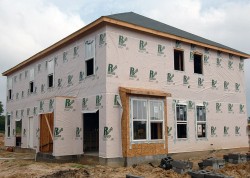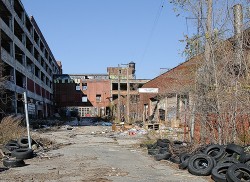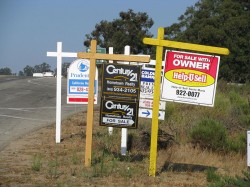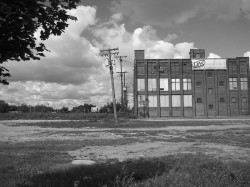 If you make your living by building or selling new homes in the United States, you might want to consider taking up a different career for a while. New homes sales in the United States hit yet another new all-time record low in the month of February, and there are a whole lot of reasons why new home sales are going to stay extremely low for an extended period of time. The massive wave of foreclosures that we have seen has produced a giant glut of unsold homes in the marketplace, mortgage lenders are making it really hard to get approved for home loans, unemployment is still rampant and the global economy looks like it may soon plunge into another major recession. None of those things is good news for the new home construction industry. The truth is that we were supposed to have seen new home sales already bounce back by now. If you look at the historical numbers, new home sales in the U.S. always increased significantly after the end of every recession since World War 2. But that did not happen this time. Instead, new home sales have just continued to decline. This is absolutely unprecedented, and economists are puzzled. So what is going to happen if the U.S. economy suffers another major downturn?
If you make your living by building or selling new homes in the United States, you might want to consider taking up a different career for a while. New homes sales in the United States hit yet another new all-time record low in the month of February, and there are a whole lot of reasons why new home sales are going to stay extremely low for an extended period of time. The massive wave of foreclosures that we have seen has produced a giant glut of unsold homes in the marketplace, mortgage lenders are making it really hard to get approved for home loans, unemployment is still rampant and the global economy looks like it may soon plunge into another major recession. None of those things is good news for the new home construction industry. The truth is that we were supposed to have seen new home sales already bounce back by now. If you look at the historical numbers, new home sales in the U.S. always increased significantly after the end of every recession since World War 2. But that did not happen this time. Instead, new home sales have just continued to decline. This is absolutely unprecedented, and economists are puzzled. So what is going to happen if the U.S. economy suffers another major downturn?
New home construction has always been one of the foundational pillars of the U.S. economy. When times were good new home construction would boom, and when times were bad new home construction would falter.
Well, unfortunately the industry is stuck in the midst of a multi-year decline right now. The reality is that you can stick a fork in the new home construction industry in the United States. It is toast. There is going to be no recovery for the foreseeable future.
Not that previously owned homes are doing that much better. According to the National Association of Realtors, sales of previously existing homes in the United States dropped 9.6 percent in February. But at least sales of previously owned homes are not at all-time record lows like new home sales are.
As you can see from the facts posted below, new home sales are absolutely abysmal right now, and there are a lot of indications that things may get even worse. The following are 18 reasons why you can stick a fork in the new home construction industry….
#1 New home sales in the United States set a brand new all-time record low in the month of February.
#2 Only 19,000 new homes were sold in the United States during the month of February. The previous record low for new home sales during the month of February was 27,000, which was set last year.
#3 The “months of supply” of new homes in the U.S. rose from 7.4 months in January to 8.9 months in February.
#4 The median price of a new home in the United States declined almost 14 percent to $202,100 in the month of February.
#5 The median price of a new home in the U.S. is now the lowest it has been since December 2003.
#6 As of the end of 2010, new home sales in the United States had declined for five straight years, and they are expected to be lower once again in 2011.
#7 Now home sales in the United States are now down 80% from the peak in July 2005.
#8 New home construction starts in the United States fell 22.5 percent during the month of February. This was the largest decline in 27 years.
#9 In February, the number of new building permits (a measure of future home building activity) declined to the lowest level in more than 50 years. In fact, new building permits were 20 percent lower during February 2011 than they were in February 2010.
#10 There is a major glut of foreclosed homes that still need to be sold off. David Crowe, the chief economist for the National Association of Home Builders, recently told CNN that the constant flow of new foreclosures being put on the market is a huge hindrance to a recovery for new home sales….
“One of the biggest detriments to building new homes is the flow of existing foreclosed homes.”
#11 The number of foreclosures just continues to increase. This means that those trying to sell new homes are going to continue to be competing against a giant mountain of foreclosed homes for the foreseeable future. An all-time record of 2.87 million U.S. households received a foreclosure filing in 2010, and that number is expected to be even higher in 2011.
#12 In fact, there are a whole lot of signs that there will be very high levels of foreclosures for years to come. For example, according to the Mortgage Bankers Association, at least 8 million Americans are at least one month behind on their mortgage payments at this point.
#13 A stunningly high number of Americans are “underwater” on their mortgages right now. This could lead to an increase in the number of “strategic defaults”. 31 percent of the homeowners that responded to a recent Rasmussen Reports survey indicated that they are “underwater” on their mortgages, and Deutsche Bank is projecting that 48 percent of all U.S. mortgages could have negative equity by the end of 2011.
#14 The truth is that the U.S. doesn’t need a whole lot of new housing at the moment. Right now, 11 percent of all homes in the United States are currently standing empty.
#15 Mortgage lending standards have become extremely tight. Back during the housing bubble, almost anyone that was breathing could get a zero-down mortgage. Today, mortgage lenders have made it extremely difficult to acquire a home loan, and it is quite typical these days for lenders to demand down payments of 20 percent or more. This is dramatically reducing the number of home buyers in the marketplace.
#16 American families cannot buy homes if they do not have good jobs. Unfortunately, it has become extremely difficult to find a job in the United States today. This is especially true if you are looking for a good job. It now takes the average unemployed worker in America about 33 weeks to find a job.
#17 There is not going to be a jobs recovery until the overall economy improves. Unfortunately, the price of oil continues to rise dramatically and economic disasters all over the planet threaten to plunge the global economy into another major recession.
#18 On top of everything else, perceptions regarding home ownership are shifting in the United States. In 1996, 89 percent of Americans believed that it was better to own a home than to rent one. Today that number has fallen to 63 percent.








